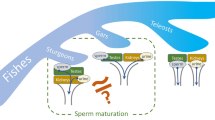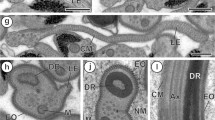Summary
Spermiogenesis and structure of the double sperm have been investigated inAcilius sulcatus andDytiscus marginalis whereas only mature double sperm have been studied inHydaticus transversalis. The conjugation of the sperm in these species is accomplished as a last step in the distal part of the vas deferens. Preconditions for the pairing are local differentiations of the sperm membrane in combination with specific layers of polysaccharids. According to their aspect as well as the chronological order and place of their appearance four such layers can be discerned. These are formed in part still in the lumen of the cyst, in part not earlier than after the anterior ends of the sperm have deeply entered into recesses of the surrounding cyst wall cells. Single sperm supplied with all layers and cytoplasmic remnants pinched off from the cyst wall cells enter the vas deferens where the cytoplasmic remainders are phagocytised by its epithelial cells. The layers of the sperm are transformed after conjugation. Thus as a last precondition for the occurrance of pairing a reaction in the vas deferens must take place. Furthermore, the development of the structural element of the tail described as “microtubular border” has been traced and identified as a “centriole adjunct” derived from nuclear material and modified to a body accompanying the flagellum. Finally, it is pointed out that apparently regular relationships in temporally correlated sequence exist between the endomembranous system and differentiating structures of the spermatid.
Zusammenfassung
BeiAcilius sulcatus undDytiscus marginalis wurde die Spermiogenese bis zu den reifen Doppelspermien, beiHydaticus transversalis wurden nur die reifen Doppelspermien untersucht. Die Konjugation der Spermien dieser Arten erfolgt als letzter Schritt erst im distalen Teil des Hodenausführungsganges. Voraussetzungen für ihr Zustandekommen sind sowohl lokale Differenzierungen der Spermienmembran, alsauch spezifische polysaccharidhaltige Beläge, von denen nach dem Aussehen sowie nach Zeitpunkt und Ort ihres Auftretens vier unterschieden werden können, die teils schon im Zystenlumen, teils erst nach Eindringen des Spermienvorderendes in tiefe Fächer der Zystenwandzellen gebildet werden. Die mit allen Belägen versehenen Einzelspermien treten zusammen mit abgeschnürten Resten der Zystenwandzellen in den Ausführungsgang ein, dessen Epithel die Plasmareste der Zystenwandzellen phagozytiert. Die Beläge der Spermien sind nach der Konjugation verändert. Damit muß als letzte Bedingung für das Zustandekommen des Aneinanderhaftens noch eine Reaktion im Ausführungsgang stattfinden. Weiterhin wurde die Entwicklung des als „microtubular border” beschriebenen Strukturelements im Schwanz verfolgt und als „centriole adjunct” identifiziert, welches sich aus Kernmaterial herleitet und zu einem Geißelbegleitkörper modifiziert hat. Schließlich wird auf anscheinend regelmäßige und in zeitlich abgestimmter Folge auftretende Beziehungen des Endomembransystems zu den sich differenzierenden Strukturen der Spermatide hingewiesen.
Similar content being viewed by others
Literatur
Acton, A. B.: An unusual ciliumlike process. J. Cell Biol.29, 366–369 (1966)
Anteunis, A.: Origin and fate of the multivesicular bodies in PHA stimulated lymphocytes. Cell Tiss. Res.149, 497–511 (1974)
Auerbach, L.: Über merkwürdige Vorgänge am Sperma vonDytiscus marginalis. Sitz. Ber. d. K. Akad. d. Wiss. zu Berlin, phys.-math. Klasse, B. XVI, S. 185–203, 23. März 1893
Baccetti, B.: Insect sperm cells. Advanc. Insect Physiol.9, 315–397 (1972)
Baccetti, B., Burrini, A. G., Dallai, R., Pallini, V., Periti, P., Piantelli, F., Rosati, F., Selmi, G.: Structure and function in the spermatozoon ofBacillus rossius. The spermatozoon of arthropoda. XIX. J. Ultrastruct. Res., Suppl.12 (1973)
Bairati, A.: Filamentous structures in spermatic fluid ofDrosophila melanogaster Meig. J. Microscopie5, 265–268 (1966)
Ballowitz, E.: Zur Lehre von der Struktur der Spermatozoen. Anat. Anz.1, 363–376 (1886)
Ballowitz, E.: Die Doppelspermatozoen der Dyticiden. Z. wiss. Zool.60, 458–499 (1895)
Bawa, S. R.: Atypical spermatozoa ofThermobia domestica — an apterous insect. Anat. Rec.142, 213–214 (1962)
Bawa, S. R.: Electron microscope study of spermiogenesis in a fire-brat insect,Thermobia domestica Pack. I. Mature spermatozoon. J. Cell Biol.23, 431–446 (1964)
Bawa, S. R.: Joined spermatozoa. In: B. A. Afzelius, ed., The functional anatomy of the spermatozoon, Proc. Sec. Internat. Symp. Stockholm: Pergamon Press 1975
Bawa, S. R., Kanwar, K. C.: Comparative fine structure of the insect spermatozoa. J. Ultrastruct. Res.37, 250–251 (1971)
Biggers, J. D., Creed, R. F. S.: Conjugate spermatozoa of the North American Opossum. Nature196, 1112–1113 (1962)
Duesberg, J.: Cytoplasmic structures in the seminal epithelium of the opossum. Contr. Embryol. Carneg. Inst.9, 47–85 (1920)
Gatenby, J. B., Tahmisian, T. N.: Centriole adjunct, centrioles, mitochondria, and ergastoplasm in orthopteran spermatogenesis. La Cellule60, 104–134 (1959/1960)
Gilson, G.: Étude comparée de la spermatogenèse chez les arthropodes. La Cellule2, 82–239 (1886)
Holstein, A. F.: Elektronenmikroskopische Untersuchungen am Spermatozoon des Opossum (Didelphys virginiana Kerr). Z. Zellforsch.65, 904–914 (1965)
Horstmann, E., Breucker, H.: Spermatozoen und Spermiohistogenese vonGraphidostreptus spec. (Myriapoda, Diplopoda). I. Die reifen Spermatozoen. Z. Zellforsch.96, 505–520 (1969a)
Horstmann, E., Breucker, H.: Spermatozoen und Spermiohistogenese vonSpirostreptus spec. (Myriapoda, Diplopoda). II. Die Spermiohistogenese. Z. Zellforsch.99, 153–184 (1969b)
Ito, S.: The lamellar systems of cytoplasmic membranes in dividing spermatogenic cells ofDrosophila virilis. J. Biophys. Biochem. Cytol.7, 433–442 (1960)
Jordan, H. E.: The spermatogenesis of the opossum (Didelphys virginiana) with special reference to the accessory chromosome and the chondriosomes. Arch. Zellforsch.7, 41–85 (1911)
Korff, K. v.: Zur Histogenese der Spermien vonPhalangista vulpina. Arch. mikr. Anat.60, 232–260 (1902)
de Lamater, E. D., Biggers, J. D.: Spermatogenesis (and spermateliosis) in the opossum,Didelphys marsupialis, by histochemical and electron microscopical methods. J. Histochem. Cytochem.12, 35–36 (1964)
Mackie, J. B., Walker, M. H.: A study of the conjugate sperm of the dytiscid water beetlesDytiscus marginalis andCofymbetes fuscus. Cell Tiss. Res.148, 505–519 (1974)
Millonig, G.: Further observations on a phosphate buffer for osmium solutions in fixation. V. Internat. Congr. EM Philadelphia, Vol. II, P-8 (1962)
Moens, P. B.: Multiple core complexes in grasshopper spermatocytes and spermatids. J. Cell Biol.40, 542–551 (1969)
Nicander, L.: A study of multivesicular bodies in the epididymis. J. Ultrastruct. Res.14, 424–425 (1966)
Oettinger, R.: Zur Kenntnis der Spermatogenese bei den Myriopoden. Samenreifung und Samenbildung beiPachyiulus varius Fabre. Arch. Zellforsch.3, 563–626 (1909)
Perotti, M. E.: Microtubules as components ofDrosophila male paragonia secretion. An electron microscopic study, with enzymatic tests. J. Submicr. Cytol.3, 255–282 (1971)
Perotti, M. E.: Microtubules as a secretion product. Boll. Zool.39, 249–254 (1972)
Phillips, D. M.: Development of spermatozoa in the wooly opossum with special reference to the shaping of the sperm head. J. Ultrastruct. Res.33, 369–380 (1970a)
Phillips, D. M.: Ultrastructure of spermatozoa of the wooly opossumCaluromys philander. J. Ultrastruct. Res.33, 381–397 (1970b)
Reger, J. F.: The fine structure of spermatozoa from the isopodAsellus militaris (Hay). J. Ultrastruct. Res.11, 181–192 (1964)
Reger, J. F., Cooper, D. P.: Studies on the fine structure of spermatids and spermatozoa from the millipedePolydesmus sp. J. Ultrastruct. Res.23, 60–70 (1968)
Reger, J. F., Dudkiewicz, A. B., Florendo, N.: The fine structure of spermatid-associated, extracellular tubules in the schizopodMysis oculata relicta. J. Ultrastruct. Res.30, 166–171 (1970)
Reger, J. F., Fain-Maurel, M.-A.: A comparative study on the origin, distribution, and fine structure of extracellular tubules in the male reproductive system of species of isopods, amphipods, schizopods, copepods and cumacea. J. Ultrastruct. Res.44, 235–252 (1973)
Retzius, G.: Die Spermien der Gastropoden. Biol. Untersuch.13, 1–100 (1906)
Retzius, G.: Die Spermien vonDidelphys. Biol. Untersuch.14, 123–126 (1909)
Reynolds, E. S.: The use of lead citrate at high pH as an eletron-opaque stain in electron microscopy. J. Cell. Biol.17, 208–212 (1963)
Sandoz, D.: Etude cytochimique des polysaccharides au cours de la spermatogenèse d'un amphibien anoure: Le discoglosseDiscoglossus pictus (Otth.). J. Microscopie9, 243–263 (1970)
Selenka, E.: Studien über Entwicklungsgeschichte der Thiere. 4. Heft. Das OpossumDidelphys virginiana. Wiesbaden: Kreidel's 1886
Shay, J. W., Biesele, J. J.: Ultrastructural observations on spermiogenesis in the cave cricketCeuthophilus secretus. La Cellule67, 269–282 (1968)
Sokoloff, J.: Über die Spermatogenese beiPolyxenus sp. Zool. Anz.44, 558–566 (1914)
Stanley, H. P., Bowman, J. T., Romrell, L. J., Reed, S. C., Wilkinson, R. F.: Fine structure of normal spermatid differentiation inDrosophila melanogaster. J. Ultrastruct. Res.41, 433–466 (1972)
Tates, A. D.: Cytodifferentiation during Spermatogenesis inDrosophila melanogaster. Thesis, Leiden (1971)
Telkka, A., Fawcett, D. W., Christensen, A. K.: Further observations on the structure of the mammalian sperm tail. Anat. Rec.141, 231–245 (1961)
Thiery, J.-P.: Mise en évidence des polysaccharides sur coupes fines en microscopie électronique. J. Microscopie6, 987–1018 (1967)
Warren, E.: On the male genital system and spermatozoa of certain millipedes. Annals of the Natal Museum7, 351–402 (1934)
Werner, G.: Untersuchungen über die Spermiogenese beim Silberfischchen,Lepisma saccharina L. Z. Zellforsch.63, 880–912 (1964)
Werner, G.: Untersuchungen über die Spermiogenese beim Sandläufer,Cicindela campestris L. Z. Zellforsch.66, 255–275 (1965)
Werner, G.: Untersuchungen über die Spermiogenese bei einem Laufkäfer,Carabus catenulatus Scop. und der Skorpion-Wasserwanze,Nepa rubra L. Z. Zellforsch.73, 576–599 (1966)
Werner, G.: On the development and structure of the neck in urodele sperm. In: B. Baccetti, ed., Comperative spermatology, Proc. I. Internat. Symp. Rome and Siena, Acad. Nazionale dei Lincei. Quaderno137, 85–91 (1970a)
Werner, G.: Spermatogenesis in the urodeles. Morphol. Aspects Androl.1, 28–31 (1970b)
Werner, G.: Changes in the spermatozoon during fertilization inTriturus Helveticus Raz. In: B. A. Afzelius, ed., The functional anatomy of the spermatozoon, Proc. II. Internat. Symp. Stockholm, pp. 47–56.: Pergamon Press 1974
Wingstrand, K. G.: The spermatozoa of the Thysanuran InsectsPetrobius brevistylis andLepisma sacchanina. Acta Zoologica54, 31–52 (1973)
Wygodzinsky, P.: On a surviving representative of the Lepidotrichidae (Thysanura). Ann. ent. Soc. Amer.54, 621–627 (1961)
Yasuzumi, G., Oura, C.: Spermatogenesis in animals as revealed by electron microscopy. XIII. Formation of a tubular structure and two bands in the developing spermatid of the silkworm,Bombyx Mori Linné. Z. Zellforsch.64, 210–226 (1964)
Author information
Authors and Affiliations
Additional information
Mit Unterstützung durch die Deutsche Forschungsgemeinschaft.
För die rasterelektronenmikroskopischen Aufnahmen der Abb. 9 danke ich Frau L. Schulz, Homburg, verbindlichst. Die Teilbilder 16g u. h konnten mit einem Siemens Elmiskop 102 aufgenommen werden. För die Anfertigung dieser Aufnahmen bin ich Frau Dr. C. Weichan, Berlin, zu Dank verpflichtet.
Rights and permissions
About this article
Cite this article
Werner, G. Entwicklung und Bau der Doppelspermien bei den DytiscidenAcilius sulcatus L.,Dytiscus marginalis L. undHydaticus transversalis Pont. (Coleoptera). Zoomorphologie 83, 49–87 (1976). https://doi.org/10.1007/BF00995430
Received:
Issue Date:
DOI: https://doi.org/10.1007/BF00995430




